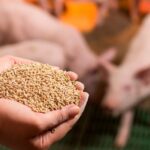You can use fumaric acid in a gluten-free diet. Fumaric acid is gluten free because of its chemical makeup. Fumaric acid is not a protein like gluten. Makers produce fumaric acid by fermenting carbohydrates or by chemical methods. These ways do not add gluten. There is no gluten in fumaric acid, so people with gluten problems or celiac disease can eat it safely. Fumaric acid is often in gluten-free foods to make them sour and taste better. You can feel sure that gluten does not get into fumaric acid during making. This makes fumaric acid a good gluten free choice for people with gluten issues.
Fumaric Acid Overview
Key Chemical Properties and Characteristics of Fumaric Acid
Fumaric acid e297 is in many foods. It looks like a white powder and has no smell. It tastes very sour and makes food taste sharp. Fumaric acid e297 does not soak up water fast. This helps dry mixes stay loose and not stick together. It stays strong even when baked at high heat. Fumaric acid e297 does not mix well in dough. This means dough stays soft and easy to press. It helps control pH in foods, so they stay fresh longer. Fumaric acid e297 stops germs from growing and keeps food safe. It is good for clean-label foods because it is vegan, vegetarian, and non-GMO.
Tip: Fumaric acid e297 is picked for gluten free foods. It makes texture and flavor better and does not hurt dough.
Common Applications of Fumaric Acid in the Food Industry
Fumaric acid e297 is used in lots of foods. You find it in gluten free tortillas, breads, and biscuit doughs. It is also in dairy foods like chocolate milk, yogurt, and cheese. Fumaric acid e297 is in candy, snacks, cereals, and desserts. You see it in fruit drinks, jams, jellies, and pie fillings. It helps keep meats and spreads fresh. Drinks like wine, beer, and cider use fumaric acid e297 to taste better and last longer.
- Some foods with fumaric acid e297 are:
- Dairy: chocolate milk, cocoa, eggnog, condensed milk, yogurt, cheese.
- Baked goods: tortillas, sourdough bread, biscuit dough, English muffins.
- Sweets: candy, snacks, cereals, desserts.
- Drinks: fruit juice, wine, beer, cider.
- Jams, jellies, pie fillings, spreads.
More people want gluten free food with fumaric acid e297. Makers use it to make dough stronger and help it rise. It also helps food last longer. Fumaric acid e297 is safe and good for clean-label foods. It helps make healthy, plant-based, and earth-friendly foods.
| Aspect | Fumaric Acid E297 | Other Acidulants (Citric, Malic, Glucono Delta Lactone) |
|---|---|---|
| Solubility | Low, does not change dough much | High, makes dough tough and hard to press |
| Effect on Dough | Keeps dough soft and not see-through | Makes dough tough and see-through |
| Leavening Reaction | Helps dough rise and get good texture | Reacts too soon, dough does not rise well |
| pH Control | Works well and stays steady | Works but can react too soon |
| Antimicrobial Properties | Keeps food fresh longer | Helps but not as much |
| Safety Profile | Safe, no bad effects | Safe but can cause dough problems |
| Functional Benefits | Strong sour taste, cheap, steady, clean-label | Sour taste, less steady, changes dough more |
Fumaric acid e297 helps make gluten free food safe and good.
Fumaric Acid Gluten Free Status

Why Fumaric Acid Is Gluten Free
You might ask why fumaric acid is gluten-free. The reason is about what it is and how it is made. Fumaric acid does not come from wheat, barley, or rye. These grains have gluten, but fumaric acid does not. Fumaric acid is found in all living things. It helps your body work right. Makers get fumaric acid by fermenting sugars or by using chemicals. These ways do not use gluten or anything with gluten.
- Fumaric acid is called gluten-free and has no wheat, soy, yeast, corn, or casein.
- Ingredient lists show fumaric acid is not from gluten grains.
- You will not see gluten or gluten parts in foods with fumaric acid.
- Fumaric acid is in many gluten-free foods and is safe for people who cannot eat gluten.
Note: Celiac experts put fumaric acid on safe gluten-free food lists. This means you can trust it as a gluten-free ingredient.
FoodSweeteners.com says fumaric acid (E297) is gluten-free. The website explains that making fumaric acid does not use gluten grains. Many gluten-free foods and drinks use fumaric acid to make them sour. This website is not from the government, but it gives clear facts about fumaric acid and gluten.
Doctors and dietitians who help people with celiac disease say fumaric acid is safe. You can find it on lists of foods that are okay for kids with celiac disease. This shows that medical experts agree fumaric acid is gluten-free and safe for anyone who avoids gluten.
Safety for Celiac Disease
If you have celiac disease or gluten problems, you must know your food is safe. Fumaric acid is gluten-free and safe for people with celiac disease or gluten sensitivity. Ingredient lists and studies support this. There are no reports of fumaric acid causing trouble for people with celiac disease.
Fumaric acid is in special food lists as gluten-free and safe for people with celiac disease or gluten sensitivity. Clinical studies tested fumaric acid and similar things for treating some diseases. These studies did not find any safety problems for people with celiac disease or gluten intolerance.
Tip: If you eat gluten-free, you can have foods with fumaric acid. It does not cause gluten reactions or celiac symptoms.
You can feel sure when you pick gluten-free foods with fumaric acid. It does not add gluten to your food and does not cause problems for people with celiac disease or gluten sensitivity. Always check labels, but you can trust fumaric acid is safe for your gluten-free diet.
Production and Contamination
Overview of the Fumaric Acid Manufacturing Process
You may wonder how fumaric acid is made and if gluten can get in. There are two main ways to make fumaric acid. The first way uses chemicals. Makers start with n-butene, which comes from oil. They change it into maleic anhydride, then maleic acid, and then fumaric acid. This chemical way does not use gluten.
The second way uses fermentation. Companies use things like corn straw, dairy manure, or crude glycerol from biodiesel. These things go through a few steps:
- Pretreatment: Workers break down plants, like corncobs, to get cellulose.
- Saccharification: Enzymes turn cellulose into sugars.
- Fermentation: Special fungi, like Rhizopus oryzae, eat the sugars and make fumaric acid.
- Separation: The last step takes the acid out of the mix.
This way uses sugars from plants, not wheat, barley, or rye. You will not find gluten in these starting materials. Both ways focus on making pure fumaric acid, so it stays free from gluten.
Note: Most companies now try to use greener ways to make fumaric acid. They use waste from farms and factories. This helps the earth and keeps gluten out of the process.
Managing Cross-Contamination Risks
You should know if gluten can get into fumaric acid by mistake. The chance of gluten getting in is very low. Makers use strict rules to keep gluten away. They do not use gluten in the process. Machines get cleaned between each batch. Workers follow safety steps to stop gluten from mixing in.
Some companies test their products for gluten before selling them. They check labels and keep records to make sure no gluten gets in. If you have celiac disease or gluten problems, you can trust fumaric acid is safe. Always read the label for new ingredients, but you will almost never see gluten with fumaric acid.
Tip: Pick products from brands you trust. Look for gluten-free labels if you want to be extra sure.
Labeling and Gluten Free Diet
Identifying Fumaric Acid in Gluten Free Food
It is important to know how to find gluten-free ingredients. Reading food labels helps you keep your diet safe. People with celiac disease or gluten sensitivity check ingredient lists. You should do this too. Look for words like wheat, barley, rye, malt, and brewer’s yeast. These mean the food has gluten. Some foods hide gluten with names like spelt, farro, or durum. Watch out for risky things like malt syrup, malt extract, modified food starch, dextrins, and regular soy sauce. These can sometimes have gluten.
Tip: Always read every ingredient on the label. Look for phrases like “may contain wheat” or “processed in a place with wheat.” Pick foods with certified gluten-free labels from trusted groups. These labels show the food meets strict gluten-free rules.
If you see fumaric acid on the label, you can trust it is gluten-free. Still, check for other ingredients that might not be safe. If you are not sure about something, ask the company or check with a trusted gluten-free source.
Tips for Gluten Free Diet
You can follow a gluten-free diet by using smart steps. First, learn which foods and ingredients are always gluten-free. Fresh fruits, vegetables, plain meats, and most dairy are safe. Pick gluten-free choices for bread, pasta, and snacks. These foods use gluten-free ingredients and fit your diet.
Here are some helpful tips:
- Pick certified gluten-free foods when you can.
- Stay updated on ingredient changes. Food makers can change recipes.
- Use help from groups like the Celiac Disease Foundation, Beyond Celiac, and the Gluten Intolerance Group. These groups give guides, expert advice, and support for your gluten-free diet.
- Check government websites for more facts. The FDA and NIH have rules and information about gluten-free labels and safe foods.
| Organization Name | Type of Resource | Contact/Access Information | Notes |
|---|---|---|---|
| Celiac Disease Foundation | Educational materials, FAQs, events, medical-reviewed info | Phone: 1-844-593-8169, Email, Social media links (Facebook, Instagram, Twitter, YouTube) | Medical info reviewed by Medical Advisory Board; nonprofit organization |
| Beyond Celiac | Awareness campaigns, research info | Website with resources on celiac disease and gluten-free living | Government-supported awareness campaign |
| Gluten Intolerance Group (GIG) | Articles, expert panels, lifestyle tips | Website with blog posts, expert discussions, and gluten-free diet guidance | Provides community support and expert insights |
It is important to follow a gluten-free diet for your health. A gluten-free diet keeps you safe from gluten reactions. You can enjoy many gluten-free foods by staying careful and informed.
You can trust fumaric acid as a gluten-free ingredient. It stays safe for people with celiac disease and fits well in a gluten-free diet. Experts say you should always read food labels and look for gluten-free signs. Choose foods with clear gluten-free labels and avoid risky additives. Use this table to help you pick safe options for your diet:
| Safe Choices | Double-Check | Avoid |
|---|---|---|
| Cow’s milk, butter | Flavored yogurts | Malted milk drinks |
| Olive oil, avocados | Cooking sprays | Alcoholic malt drinks |
Tip: Ask a celiac expert if you have questions about your gluten-free diet.
FAQ
Is fumaric acid safe for people with celiac disease?
You can eat fumaric acid if you have celiac disease. Experts say it does not contain gluten. You will not get a gluten reaction from foods with fumaric acid.
Can you find fumaric acid in gluten-free bread?
You often see fumaric acid in gluten-free bread. It helps the bread rise and taste better. You can trust it as a safe ingredient in gluten-free baked goods.
Does fumaric acid come from wheat or barley?
You do not get fumaric acid from wheat or barley. Makers use chemical or plant-based methods. These ways do not use gluten grains.
Tip: Always check the ingredient list for hidden gluten sources.
How do you know if a product with fumaric acid is gluten free?
You should look for a gluten-free label on the package. You can also check the ingredient list. If you see fumaric acid and no gluten grains, the product is safe.
| Label Phrase | What It Means |
|---|---|
| Gluten-Free | Safe for you |
| Contains Wheat | Avoid this product |
| Certified Gluten-Free | Meets strict standards |




